Camellia spp.
In the fall and winter landscapes, it can be a challenge to keep the yard or garden interesting and color plentiful.
Winter can be bleak and lifeless – unless, of course, your garden is graced with a camellia. When most plants are dormant or have died off, camellias become a prolifically blooming feature, showing off both blossoms and evergreen foliage.
In climates that don’t experience harsh seasonal conditions, pollinators can be active through mild winters and camellias will offer important forage for them.
There are more than 45 species of this flowering plant in cultivation, 30,000 named varieties, and more than 3,000 hybrids. Most hybrids are derived from two species: C. japonica and C. sasanqua.

We link to vendors to help you find relevant products. If you buy from one of our links, we may earn a commission.
Some hybrid varieties have been bred to withstand higher or lower temperatures, and some produce spectacular blossoms unlike any other in form or color.
With so many gorgeous types available, it might be tough to choose the one you want to add to your landscape. Let’s discuss some options, and the preferred methods for nurturing your camellia at home.
What You’ll Learn
Cultivation and History
The first known camellias were cultivated over 5,000 years ago in ancient Japan and China.
The plants grew wild throughout Asia and were prized not only for their beauty, but for a variety of other purposes as well, most of which continue to be common today.
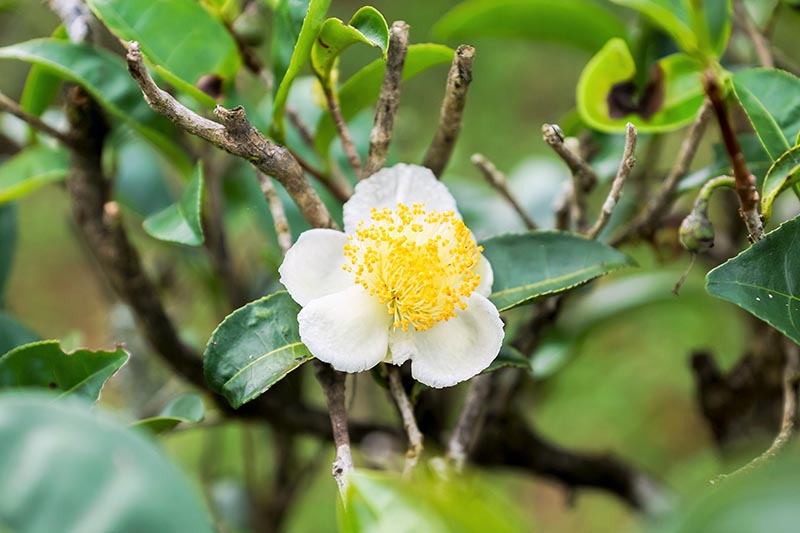
Known in Japan as tsubaki and China as chahua or “tea flower,” the dried and fermented leaves of C. sinensis are used to make tea.
Another species C. olifeira, is cultivated and processed for oil. This oil is used in cosmetics and for cooking.
As popularity grew, two ornamental species were selectively bred to become the parents of hundreds, and continue to be the two most popular ornamental types today – C. japonica and C. sasanqua.
These were the focal point of many gardens throughout Asia, as followers of the Shinto religion believed that their gods descended to Earth to inhabit camellia blossoms.
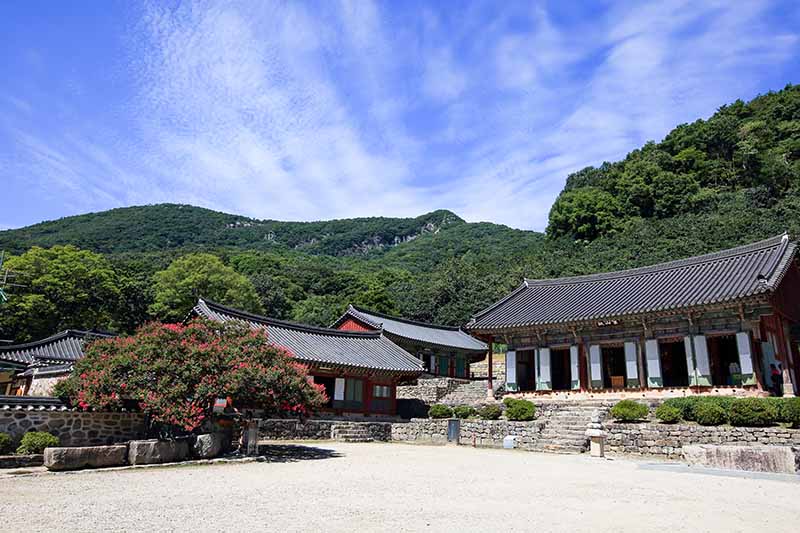
In temples, cemeteries, and homes of the nobility throughout Asia, camellias were considered an essential part of the landscape. Some of those planted at the emperor’s palace in Japan are known to be more than 500 years old.
The flowers were and continue today to be sent to those in mourning, and for thousands of years the flowers have also been regarded as muses, inspiring artwork and decor.
They also feature prominently in floral arrangements and have been the focal point of many a bridal bouquet. While the pink camellia symbolizes love and affection, white is a symbol of longevity, and red blooms symbolize passion.
These are the most commonly available colors. But C. nitidissima, a less common species, produces yellow blossoms and has been hybridized to produce new varieties in various shades of yellow and gold.
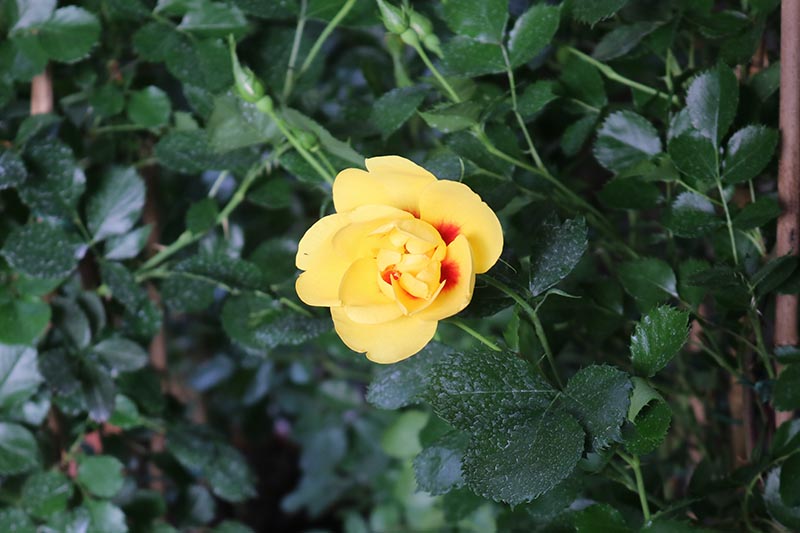
In the 18th century, the first live plants arrived in Europe, transported by the East India Trading Company.
Camellias quickly became a beloved garden plant throughout Europe, and consuming tea as an everyday practice spread in popularity as well.
Plants can be grown in a bush or tree form, and are popular choices for the espalier growing technique, trained to grow flat against a wall or fence.
Most varieties grow at a slow to moderate speed and can live for more than one hundred years.
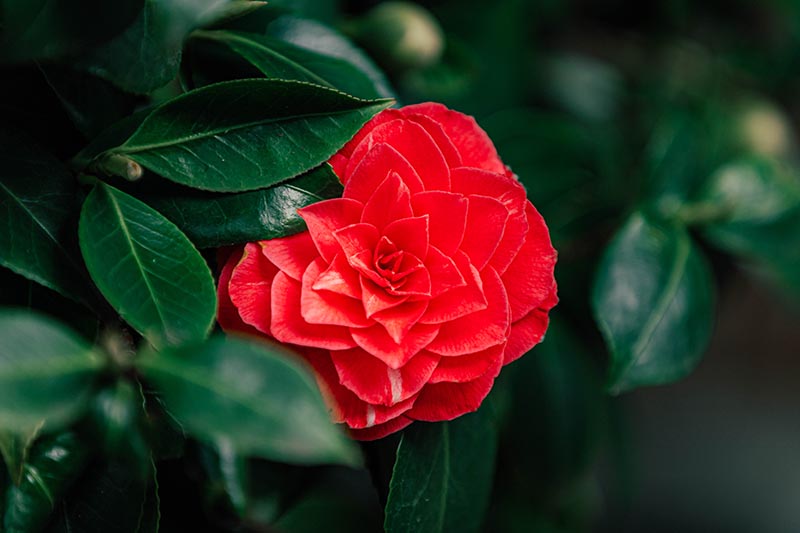
In the United States, most camellia species are hardy in Zones 7 to 10, with some hybrids that are suited to Zones 6 and 11 as well. Most varieties bloom between fall and spring.
While several hybrids have been developed for improved fragrance, most varieties are grown for their visual appeal, as flowers do not naturally have a noticeable scent.
Camellias are so popular that quite a few societies and clubs exist today that are dedicated to the history, cultivation, and preservation of heirloom varieties, such as the American Camellia Society.
Camellia Plant Propagation
Growing camellias from seed is easy; however, those grown from seed almost never produce a plant resembling the parent.
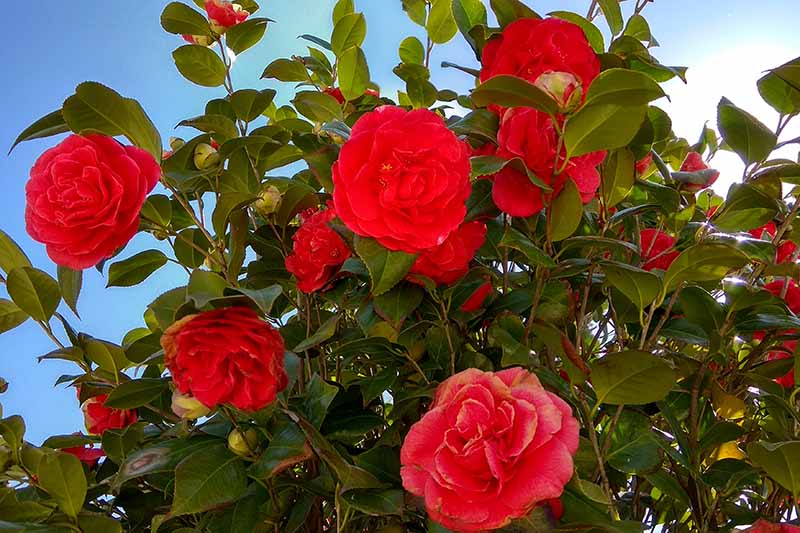
If you’re willing to take your chances to see what unique blossoms your plant might produce, seed is the way to go.
Consider a different method of propagation if you want the resulting offspring (or clones) to better resemble their parents.
There are a number of propagation methods available to gardeners, including rooting cuttings, grafting, layering, and air layering, which are discussed in detail in our guide to propagating camellias.
How to Grow Camellia Flowers
Camellias are considered perennial evergreens and can be grown as shrubs or trees, reaching mature heights of 10 to 20 feet on average, although some specimens have grown far larger.
Weeping and dwarf varieties exist as well.
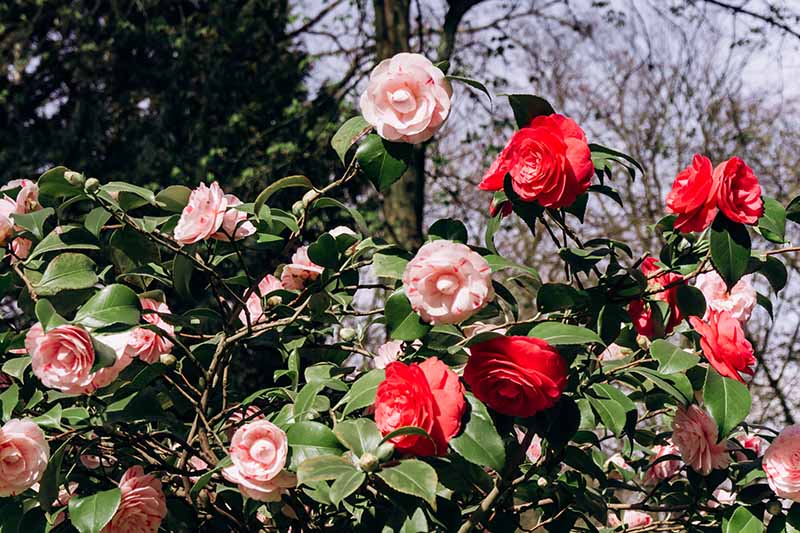
They have a reputation for being fussy and challenging to keep healthy. Often, the problem is inadequate preventative care or a poor choice of planting site, leading to untimely death or disease.
It’s best to plant or propagate camellias in the spring.
Prior to planting in-ground, test the soil pH. These shrubs prefer a slightly acidic pH of 5.5 to 6.5.
A variety of test kits can be purchased, such as the MySoil Test Kit, available via Amazon, which gives a detailed picture of not only the pH, but the overall health of your soil.
If soil pH is too high, or too alkaline, adding sulfur will lower the pH. If pH is too low, or too acidic, adding lime will increase it.
Amending soil at the planting site with used coffee grounds, bone meal, and aged manure will provide acidity and added available nutrients to keep your plants thriving.
Fertilizer can be added if desired by using a blend formulated for camellias and other woody broadleaf shrubs, such as this Natural Guard organic fertilizer, available from Nature Hills Nursery.
Ideally, the planting site should be in full sun in the morning and partial shade through the rest of the day. A spot under a large tree or against the north side of your house may work best.
Learn more about companion planting for camellias here.
Young plants prefer more hours of shaded, indirect sunlight than more mature plants, as they are more sparse.
As plants grow and mature, their dense foliage will help to form a canopy that can protect them from overexposure to the sun.
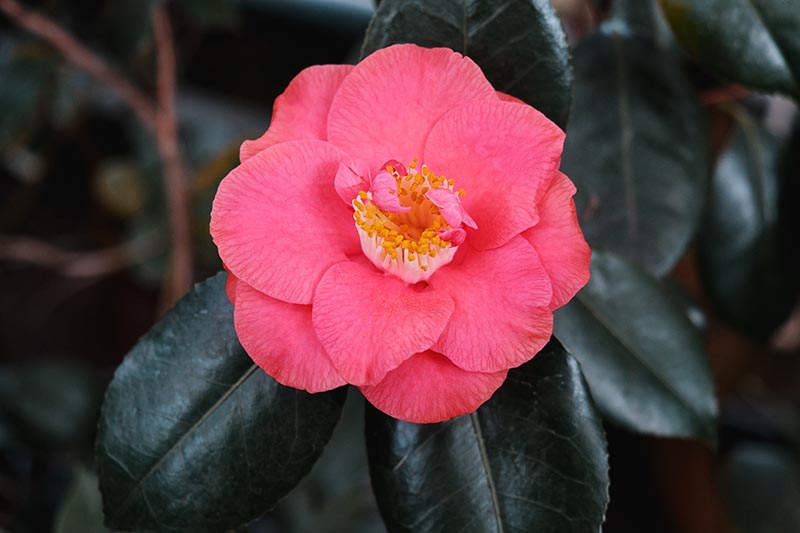
Good drainage is imperative for healthy plants as they are extremely intolerant of soggy soil. Too much moisture can lead to problems like bud drop.
Conversely, drought conditions are not tolerable and will also lead to an unhealthy specimen. It’s important to maintain even soil moisture, especially in the fall when buds are forming.
Water plants to wet the entire root ball and use a layer of mulch to keep roots moist and protected. Observe the moisture of the soil one to two times per week, and if the top layer feels dry to the touch, irrigate deeply with one to two inches of water. This is essential when plants are sprouting new growth.
Protect plants from cold, harsh winds by wrapping them with garden cloth or planting in a sheltered area.
A major mistake that many gardeners make is to plant potted transplants too deep. The roots need good aeration, and if buried too deeply, they will suffocate.
Prepare a hole as deep as the root ball, and several inches wider to remove any competing roots from neighboring plants.
Camellia plants should be spaced at least five feet apart, and ideally eight to 12 feet, unless they are being planted as part of a hedgerow.
Mound compost or peat moss at the bottom of the hole to create a small hump; this allows the plant to be seated without dropping too deeply and keeps roots at ground level as soil compacts.
Container Planting
Some varieties are well suited for container planting and will do quite well with light pruning. A large planter is preferred to avoid having the plant become root bound.
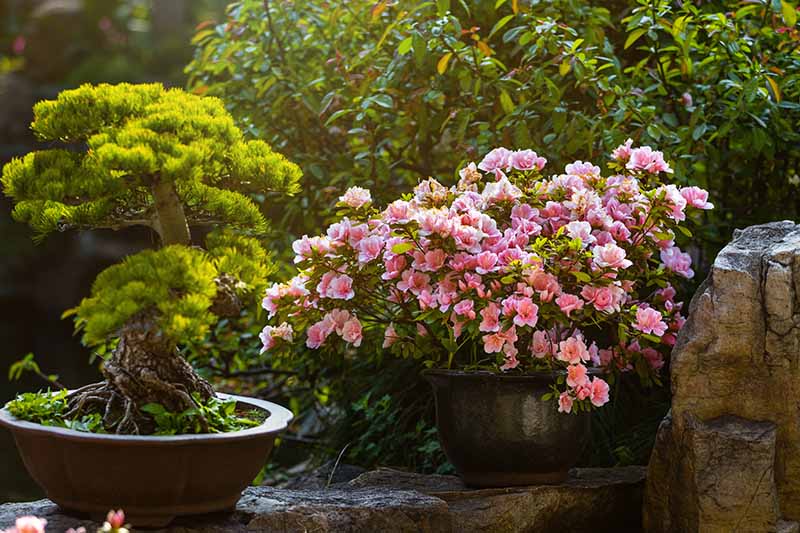
If you live in an area with poor soil, such as in the southern United States where soil can be sandy and difficult to amend, container growing can be a better choice.
If you plan to give your camellia a permanent home in a pot, learn more about that in our full guide to container care.
Growing Tips
- Choose a planting site or container with good drainage to prevent soggy soil.
- Maintain consistent moisture for optimum plant health.
- Choose a location with partial shade, or morning sun and afternoon shade.
- Avoid planting too deeply.
- If you find that your plants aren’t producing blooms, check our troubleshooting guide for tips.
Pruning and Maintenance
Pruning is not typically necessary for camellias and can even cause some damage if overdone. Wounds left by pruning can leave plants open to disease.

Deadheading is recommended, and should be done throughout the blooming season. Pinch off blossoms that are wilted or dead, and discard them.
Dead blooms, if healthy, can be composted. Deadheading promotes foliage and root growth between blooming seasons.
Pruning dead or weakened branches is also recommended, and can be done at any time.
If you find yourself on the business end of a giant specimen that has outgrown its space – and bear in mind that some varieties can grow larger than twenty feet – you may need to consider pruning it back.
Find tips on how to prune your camellias here.
Established plants will appreciate a twice-yearly application of a slow release, balanced fertilizer such as 10-10-10 (NPK) in the spring and again in fall, according to package instructions.
In the case of younger plants, you can use a fertilizer specifically made for camellias, such as Natural Guard, mentioned above.
Learn more fertilizing camellias here.
Camellia Cultivars to Select
Because camellias have been cultivated so widely for such a long time, and for so many purposes, there is an expansive list of varieties in existence.
Plants of the C. sasanqua species typically bloom from October through December. They’re generally more tolerant of sun exposure and tend to have larger blooms.
C. japonica typically blooms from January through March. These generally prefer shade and warmer temperatures.
Some cultivars have been bred to improve fragrance or to produce blooms as large as five inches in diameter. Others are more modest, but offer much-needed color during winter months, with a long blooming season.
Here are a few to get you started:
Jury’s Yellow
‘Jury’s Yellow’ flowers have stunning white petals at the blossom border, with a section of creamy yellow petaloids in the center of full double blooms.
The deep gold to orange stamens can add to the depth of the yellow central color.
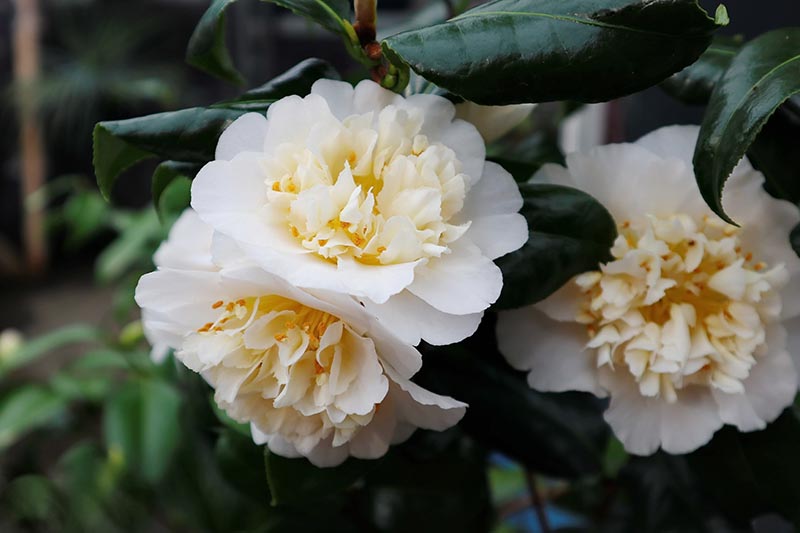
This cultivar, bred in New Zealand by Les Jury, is a hybrid cross between C. japonica, C. chrysantha, and C. williamsii that blooms between late fall and early spring in Zones 7 to 9.
‘Jury’s Yellow’ can be a profuse bloomer, with a rounded to upright growing habit reaching eight to twelve feet in height, and dense, deep green foliage, creating a truly eye-catching contrast that will stand out in your landscaping.

You can pick up ‘Jury’s Yellow’ in quart-sized containers from New Life Nursery and Garden via Amazon.
Professor Sargent
The popular C. japonica ‘Professor Sargent’ cultivar offers deep red, peony form flowers, that bloom between November and March, adding color and interest to the garden.

The densely packed petals of ‘Professor Sargent’ have been a favorite among camellia growers for decades; the full, lush blossoms being very popular as cut flowers.
With a vigorous growth habit and extended bloom season, this cultivar is often used in hedgerows, or grown as a specimen plant, in Zones 8 to 10. Shrubs reach mature heights of 12 to 15 feet.
‘Professor Sargent’ is also suitable for container planting.
You can find plants available in two-and-a-half-quart and #3 containers available from Plants by Mail.
Shi Shi Gashira
One of the most popular fall-blooming varieties, the dark pink, semi-double blossoms of C. sasanqua ‘Shi Shi Gashira’ are just what fall-foraging pollinators are looking for.
This cultivar has a more compact growth habit than other varieties, and more sun tolerance, especially as plants mature.
Plants in one- and three-gallon containers are available from Fast Growing Trees.
Want More Options?
Be sure to check out our follow on guide, “11 of the Most Beautiful Camellia Varieties to Grow at Home.”
Managing Pests and Disease
Camellias can fall victim to quite a few problems that are common among many ornamental plant species.
Foraging animals, insects, and disease can take quite a toll on your plants, and some issues – like root rot – can unfortunately be deadly.
Deer, squirrels, and voles may partake of various parts of your plants throughout the fall and winter seasons. Scale, aphids, spider mites, and bud mites can cause major infestations and spread disease.
Keeping an eye out for early signs of infestation or infection can help to prevent further spread.
Preparing your plants for winter is also a smart preventative measure that can help you to avoid having weakened plants on your hands that are more susceptible to illness.
In any instance when chemicals or poisons will be applied to your garden or yard, it’s extremely important to use these substances carefully and exercise extreme caution.
Chemicals and poisons will not only become a part of the plants and soil in your yard, but can become a part of the groundwater and water sources as well, and impact wildlife in the area, causing unintended and sometimes long term damage.
Find detailed information on troubleshooting problems in our guide to identifying and fixing problems with your camellia.
Best Uses for Camellia Shrubs and Trees
Camellias have been used for centuries as hedges and garden features, often trimmed into a tree form, or trained to grow along a frame or wall with the espalier method.

When planted in the home garden, these plants can live for more than one hundred years, and become an annually anticipated source of winter-blooming joy.
Cut flowers are extremely popular in bridal bouquets as well as arrangements sent to those in mourning.
C. sinensis leaves are dried for tea and can be grown at home and processed for this purpose.
Quick Reference Growing Guide
| Plant Type: | Evergreen, semi-herbaceous, flowering shrub | Flower / Foliage Color: | White, red, pink, yellow/green, dark green |
| Native to: | Asia | Maintenance: | Moderate to high |
| Hardiness (USDA Zone): | 7-10 | Tolerance: | Shade |
| Season: | Fall, winter, spring | Soil Type: | Organically-rich loam |
| Exposure: | Morning sun, part to full shade | Soil pH: | 5.5-6.5 |
| Spacing: | 5 feet or more | Soil Drainage: | Well-draining |
| Planting Depth: | Slightly above soil grade (transplants), 1/2 inch (seeds) | Attracts: | Bees, butterflies, hummingbirds |
| Growth Rate: | Moderate | Uses: | Cut flowers, hedges, featured specimen, tea |
| Height: | 1.5-60 feet | Family: | Theaceae |
| Spread: | 3-40 feet | Genus: | Camellia |
| Water Needs: | Moderate | Species: | Japonica, nitiddisima, olifeira, reticulata, sasanqua, sinensis |
| Common Pests: | Aphids, mites, scale. | Common Diseases: | Algae leaf spot, camellia petal blight, canker, leaf gall, root rot |
Camellias Offer Beauty When Other Plants Are Dormant
Plants that have been a beloved addition to landscapes and gardens for hundreds of years, such as the camellia, must be doing something right.
In this case, versatility, multiple uses, seasonal interest and color, and pollinator forage are obvious reasons why these shrubs have endured.
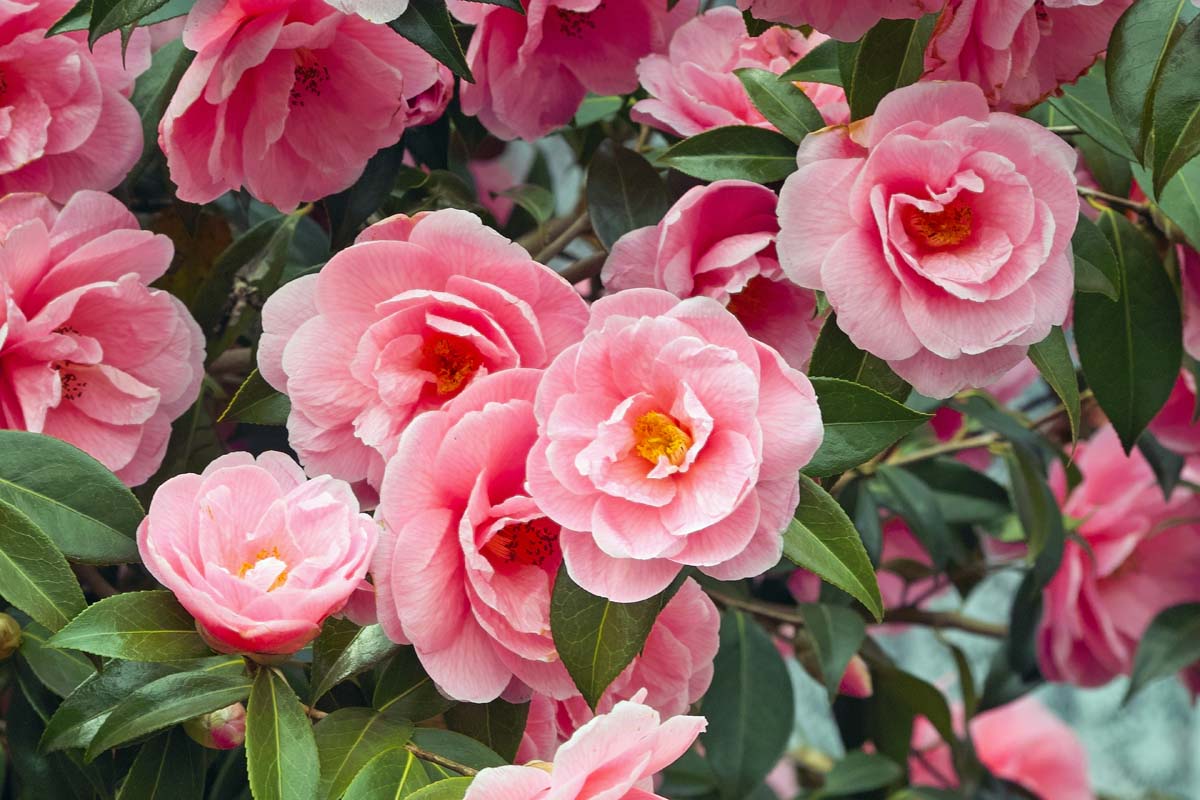
Whether trimmed into a privacy hedge, shaped into a tree, or added as a naturally stunning feature, the camellia holds great appeal.
With some attention, a well-established plant may live on well past our lifetimes, leaving a living legacy behind.
Keep those colorful blooms coming throughout the year by adding more flowering shrubs to your landscape. You can stagger planting for blossoms nearly year round.
Are you growing camellias in your garden? Let us know in the comments section below and feel free to share a picture!
And for more tips on caring for camellia flowers, you’ll need these guides next:
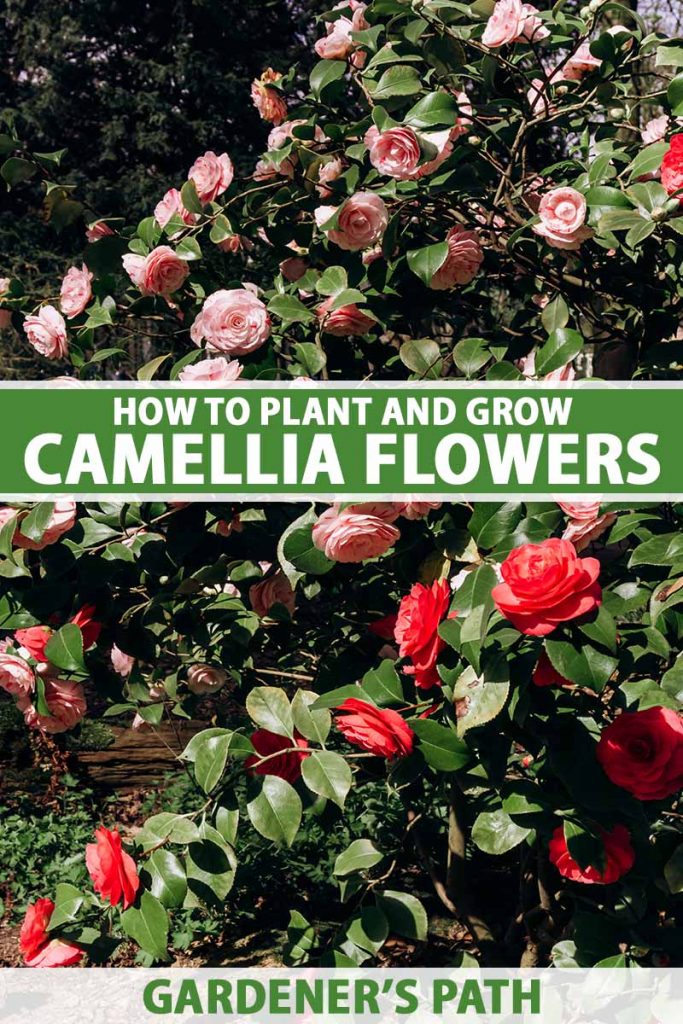
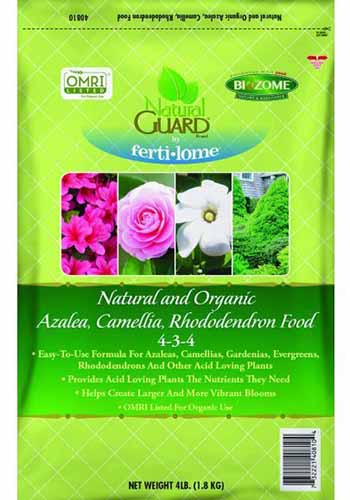
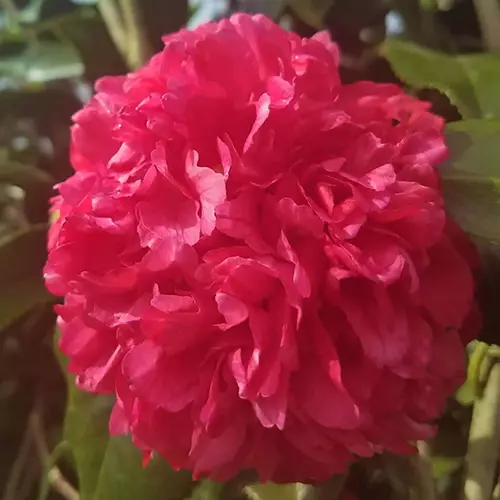

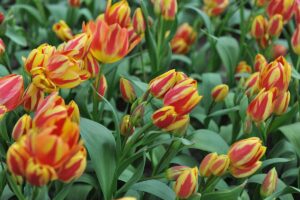
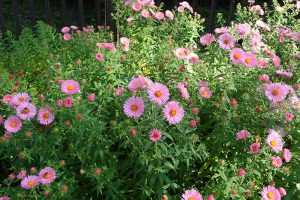

Hello, I was trying to reach Kelly Spicer with a question about the camellia article. I live in zone 7. The power company took down some trees under a powerline and I’m looking to replace with something beautiful (no more than 12 feet tall) like a few camellias. I’m looking for her advice on, what would be a tall variety with a beautiful color/bloom and that could take a lot of sun in North Carolina? I could leave it to grow to its full height and even make somewhat a hedge with several. thank you for any advice you can… Read more »
Hi Barbara, I’d be happy to help! It sounds like ‘Debutante’, with its pink, peony-form flowers, would be a good choice. It grows 10-12 feet and blooms from October through May. ‘Jordan’s Pride’ has pink and white blossoms on a 12-foot shrub. If you prefer red,
‘Yuletide’ is a popular choice and it grows to about 10 feet. Any of these would prefer a little afternoon shade but should be fine in full sun.